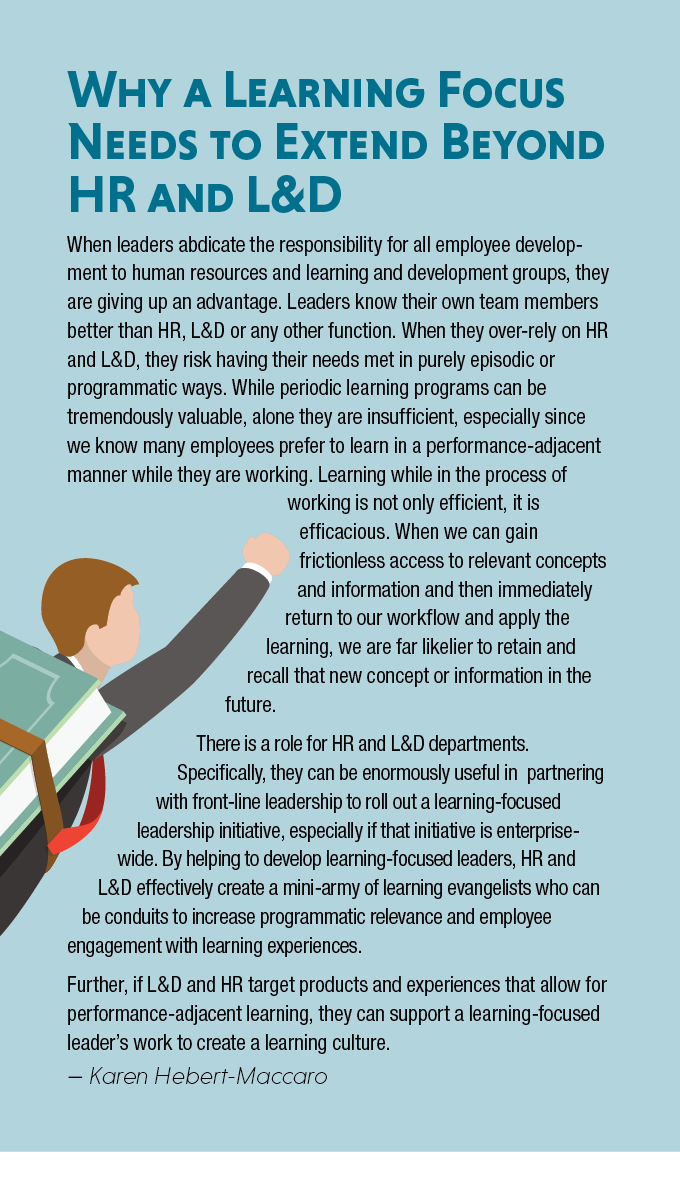The relationship between learning and leading is not a new idea. In a 1990 speech delivered to McKinsey & Co., John W. Gardner, Stanford professor and policy developer under the Lyndon Johnson administration, said the most pressing need for leaders was to focus on “personal renewal.” He urged leaders to be interested, not just interesting, and to seek out information and experiences that would help them continuously learn and grow. He put it best when he said, “We can’t write off the danger of complacency, growing rigidity, imprisonment by our own comfortable habits and opinions.”
The danger of complacency may never be more relevant to organizational and individual success than it is right now. The average shelf-life of a skill has shrunk to five years, according to LinkedIn Learning’s “2017 Workplace Learning Report.” Organizations and individuals who aren’t constantly learning, upskilling and reskilling risk obsolescence. According to the World Economic Forum’s “The Future of Jobs Report,” it is possible that more than 7.1 million professional jobs will be eliminated by 2020. New roles and jobs will emerge to take some of those who are displaced, but in many instances they will be for positions that do not exist today. The same WEF report indicated that 35 percent of core job skills will change by 2020.
The nature of change in careers and organizations justifies the need to continually learn, but even without this need the value of learning-focused leadership exists. Recent research published in a Harvard Business Review article, “Good Leaders Are Good Learners,” found that leaders who were in “learning mode” developed better leadership skills than their peers not in learning mode. The researchers found that leaders in learning mode benefited by adopting a growth mindset (popularized years ago by professor Carol Dweck), experimenting with alternative strategies and approaches to problems, and through their committed use of after-action reviews and post mortems to learn from the results of their experimentation. These characteristics allow leaders to be more agile in adapting to changing environments as well as to think creatively about how to approach challenges.
An Approach, Not a Style
Learning-focused leadership is not a leadership style. Walking down the business aisle of a bookstore or perusing an online book list quickly tells you that there are a plethora of suggested leadership styles, all with claims of relative efficacy and appropriate contexts for adoption. This body of work is thought to have started with Kurt Lewin, who in the 1930s and 1940s led a group of researchers toward the uncovering of three  leadership styles: authoritarian/autocratic, participative/democratic and delegative/laissez-faire.
leadership styles: authoritarian/autocratic, participative/democratic and delegative/laissez-faire.
The primary differences in these styles is that the authoritarian leader makes decisions alone, the participative leader includes the opinions of others and the delegative leader lets workers make decisions while still accepting responsibility for the outcomes. Based on the simple definitions of these three styles, still cited today in leadership research, it is clear that a leader can be more or less learning-focused while also involving others in decision-making to greater or lesser degrees. Admittedly, the autocratic leader may have more of a hill to climb to adopt a learning-focused approach, but it is not inconceivable. When considering the wealth of other styles that have caught our attention since Lewin’s seminal work, we see a bias toward styles that are, in general, very aligned with a learning focus, such as transformational leadership, coaching leadership and strategic leadership.
Learning-focused leadership is an approach, not a style, simply by virtue of being agnostic of style, and hopefully it is therefore more enduring. It is an approach characterized by a set of behaviors and actions that are powered by core beliefs about the value of being learning-oriented, and it can be applied by leaders using a variety of leadership styles.
Values and Behaviors of Learning-Focused Leaders
Learning-focused leaders, or LFLs, commit to a learning orientation. Having a learning orientation means you see value in learning new things, you seek out new challenges, and you see learning as key to your growth and success. LFLs also promote their orientation and way of viewing the world among others.
LFLs adopt growth mindsets. Dweck’s “Mindset: The New Psychology of Success” describes a growth mindset as a state of believing that intelligence can grow and that you can get smarter through effort. She contrasts this to a fixed mindset, where there’s a belief the intellect is fixed, talent either exists or doesn’t, and intelligence can’t be changed with effort. Leaders with a fixed mindset are likely to struggle adopting a learning orientation — they won’t see the associated behaviors and actions as fruitful. Leaders with a growth mindset are inherently oriented toward learning.
 LFLs also model learning-focused behaviors. Like any effective approach to leadership, leaders must be authentic. Authenticity comes, at least in part, by not just espousing beliefs or commitments but actually living them in your behaviors and actions. LFLs can do this by adopting several specific practices.
LFLs also model learning-focused behaviors. Like any effective approach to leadership, leaders must be authentic. Authenticity comes, at least in part, by not just espousing beliefs or commitments but actually living them in your behaviors and actions. LFLs can do this by adopting several specific practices.
First, get into the habit of developing and sharing personal and professional learning commitments and goals.
Ask a lot of questions. Being inquisitive about others’ work and talents is a way to learn and to show others that you expect everyone to be both a teacher and a learner at times.
Make sure annual performance review and goal-setting processes include the consideration of opportunities aligned with team members’ growth goals and personal aspirations. Hold them accountable to these as you would a performance goal.
Design learning agendas for your team. This can be as simple as mapping strategies to initiatives and team skills. Not only does this give you a snapshot of what your team’s relative strengths and weaknesses are vis-a-vis the project or goal, but it can serve as a prompt for conversation about how to build skills and identify team member interests that align with the gaps.
Prompt regular 360-degree communication. This process requires the encouragement of all points of view, enabling dissent and disagreement, and listening to risky, contrary and new ideas. It helps if leaders focus on data-driven conversations whenever possible to avoid conversations that feel judgmental. Successful 360-degree communication occurs when the leader fosters a relationship among the team members that actually promotes divergent thinking and professional disagreement, because this is where you find the most creativity and growth. In a 2017 Harvard Business Review article, “True Leaders Believe Dissent Is an Obligation,” author Bill Taylor, co-founder of Fast Company, says leaders must adopt an “obligation to dissent.” This is critical to the process of establishing the practice of 360-degree communication.
Embrace failure as part of the learning process. The failure-tolerant leader is someone who can discuss reasonable failures without blame and help others learn from them, according to Richard Farson and Ralph Keyes’ Harvard Business Review article, “The Failure-Tolerant Leader.” To do this, leaders must cultivate a culture of reflection. One practice that allows for this type of reflection is after-action reviews. This type of analysis takes complex results and explores the successes and failures within them to see what can be learned for the future.
Finally, hire for a growth mindset. Look for team members who have a learning orientation and place value on that characteristic in the hiring process.
Learning-Focused Leaders are Good for Business
Research conducted by Bersin & Associates in 2010 found that companies with learning cultures were 30 percent more likely to be market leaders. Learning cultures only take root when learning-focused leadership is in place. Unfortunately, that same study revealed that only 10 percent of the organizations that participated had a successful learning culture and only 20 percent of employees exhibited effective learning behaviors at work. Learning-focused leadership may be overdue.
While there are countless definitions of “learning culture,” the following from a 2015 Society of Human Resource Management article, “How to Create a Learning Culture,” is useful in this context: “A learning culture consists of a community of workers instilled with a ‘growth mindset.’ People not only want to learn and apply what they’ve learned to help their organization, they also feel compelled to share their knowledge with others.”
The concepts of continuity and openness are also worth adding to any learning culture definition. Specifically, the desire to learn and then apply and share learning must be a continuous and open process to cultivate and sustain a learning culture.
Regardless of definition, one can see how LFLs can accelerate the creation and support of an organization’s learning culture. LFLs can magnify the impact of a learning culture by ensuring it is aligned with the important and strategic work of the organization.
Learning-focused leadership is a way to supercharge your ability to lead. It can make you and your team adaptable and flexible enough to meet the changes of the fast-paced technological and business landscapes in which we all work. It isn’t a mystical concept. It can be cultivated and practiced. If you choose to do so, it will magnify your impact and make work more engaging, more fulfilling and more productive for you and everyone you lead.
Karen Herbert-Maccaro is chief learning experience officer at O’Reilly Media Inc. She can be reached at editor@CLOmedia.com















